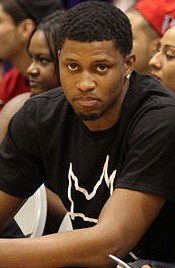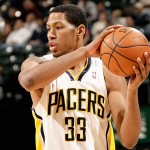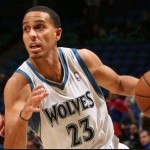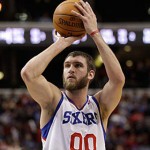 The NBA holiday shopping season is upon us a little early this year.
The NBA holiday shopping season is upon us a little early this year.
It usually starts December 15, the first day players who were signed in the offseason become eligible to be traded. But after seeing Rudy Gay’s immovable contract somehow sent from Toronto to Sacramento, it is clear that shopping season is under way.
Come next Sunday, NBA general managers will have increased flexibility when looking to improve their rosters, which was Kings GM Pete D’Alessandro’s approach in acquiring Gay, or their payroll, which was Raptors GM Masai Ujiri’s approach in moving him.
In addition to the Raptors-Kings deal, we’ve already heard reports that the Houston Rockets are telling teams reserve center Omer Asik is on the block and they are looking to move him between Sunday and Dec. 19, which is the deadline for any player acquired for Asik to be rerouted before the trade deadline on Feb. 20.
So Rockets GM Daryl Morey may make two deals. Or he may make one deal. Or he may not deal at all.
But whom will he be dealing with? In all likelihood, teams that figure to be active between now and the trade deadline have at least one of these three assets: (a) salary cap room; (b) trade exceptions; (c) a big expiring contract.
Just four teams have room below the cap. All are in some stage of rebuilding and may be reluctant to fill that room with anything other than a player on his rookie contract or an expiring deal, plus a draft pick.
Thirteen teams have trade exceptions ranging from $760,000 to $11 million. Some expire as early as January but most expire in early July. Five teams have multiple trade exceptions, but they cannot be pooled for a single deal.
However, trade exceptions can be fragmented to acquire multiple players. They also can be used to claim waived players. And they come with a $100,000 cushion.
Finally, there are 23 players spread among 17 teams with expiring deals worth at least $6 million. Teams with two such deals on their books are Dallas, Detroit, Orlando and Washington. Utah has three.
Regardless of how many deals there are between now and Feb. 20, don’t expect any more 2014 draft picks to change hands. This draft class has somehow approached its ridiculous hype and will be the deepest in a decade.
Let’s take a look at the assets of certain teams and how they may be used:
TEAMS WITH CAP SPACE
| TEAM | PAYROLL | CAP ROOM |
| Philadelphia | $47.9 million | $10.8 million |
| Phoenix | $52.9 million | $5.8 million |
| Utah | $56.73 million | $1.9 million |
| Milwaukee | $56.82 million | $1.8 million |
The 76ers are not just below the cap of $58.679 million; they are beneath the floor of $52.811 million, which is 90  percent of the cap. Unless they acquire a player between now and July 1, they will have to write a check of about $5 million to the Players Association.
percent of the cap. Unless they acquire a player between now and July 1, they will have to write a check of about $5 million to the Players Association.
While the cap room for Utah and Milwaukee is negligible, both Philadelphia and Phoenix have enough cap room to be a third-team facilitator in a trade and pick up draft picks, expiring contracts or a desirable young player in the process.
Let’s say Indiana decides it needs more offense. The Pacers could move injured Danny Granger’s $14 million expiring deal to Boston for Jordan Crawford ($2.2 million, $3.2 million). The Celtics would need to make the outgoing salaries match and could move Kris Humphries (expiring $12 million) to Philadelphia, which could also request one of Boston’s multiple first-round picks. The Pacers get a scorer and reduce payroll, the Celtics get a former All-Star or his cap slot and the Sixers meet the floor and add a pick.
TRADE EXCEPTIONS
| TEAM | PLAYER | AMOUNT | EXPIRES |
| GSW | R.Jefferson | $11,000,000 | July 10 |
| BOS | P.Pierce | $10,280,000 | July 14 |
| DEN | A.Iguodala | $9,870,000 | July 10 |
| MEM | R.Gay | $7,500,000 | Jan. 30 |
| OKC | K.Martin | $6,500,000 | July 11 |
| GSW | B.Rush | $4,000,000 | July 10 |
| LAC | E.Bledsoe | $2,630,000 | July 10 |
| OKC | E.Maynor | $2,340,000 | Feb. 21 |
| MEM | W.Ellington | $2,080,000 | Jan. 22 |
| ORL | G.Ayon | $1,500,000 | Feb. 21 |
| MEM | H.Haddadi | $1,300,000 | Jan. 30 |
| IND | Mi.Plumlee | $1,280,000 | July 28 |
| WAS | E.OKafor | $1,250,000 | Oct. 27 |
| TOR | A.Bargnani | $1,220,000 | July 10 |
| MIA | D.Pittman | $854,000 | Feb. 21 |
| NYK | R.Brewer | $850,000 | Feb. 21 |
| MEM | J.Selby | $760,000 | Jan. 22 |
| GSW | J.Tyler | $760,000 | Feb. 21 |
| GSW | M.Lee | $760,000 | June 27 |
| MIN | M.Lee | $760,000 | June 27 |
| WAS | J.Crawford | $415,000 | Feb. 21 |
| BOS | F.Melo | $280,000 | Aug. 15 |
Golden State and Memphis each have four exceptions of varying amounts. Boston, Oklahoma City and Washington have two apiece. And yes, Malcolm Lee repesents small trade exceptions for two teams, having been dealt twice on draft day.
Trade exceptions are good for a year and in most cases simply expire. The Orlando Magic had a $17 million exception  from the Dwight Howard deal that evaporated without even a portion of it being used.
from the Dwight Howard deal that evaporated without even a portion of it being used.
There is an intriguing situation in Oklahoma City, where the Thunder have a $6.5 million exception from their sign-and-trade with Minnesota over the summer and could use it to fortify their bench by trading for someone like Spencer Hawes ($6.6 million).
One thing to remember about the use of trade exceptions: They exchange imaginary money for real money. If the Thunder acquired Hawes, his salary would count against the cap and drive the payroll above the tax threshold. And we all know how owner Clay Bennett feels about that.
BIG EXPIRING CONTRACTS
| PLAYER | TEAM | EXPIRING |
| Dirk Nowitkzi | DAL | $22,720,000 |
| Pau Gasol | LAL | $19,300,000 |
| Paul Pierce | BRK | $15,300,000 |
| Emeka Okafor | PHX | $14,490,000 |
| Luol Deng | CHI | $14,300,000 |
| Danny Granger | IND | $14,020,000 |
| Ben Gordon | CHA | $13,200,000 |
| Andrew Bynum | CLE | $12,250,000 |
| Kris Humphries | BOS | $12,000,000 |
| Hedo Turkoglu | ORL | $12,000,000 |
| R. Jefferson | UTH | $11,050,000 |
| Shawn Marion | DAL | $9,300,000 |
| Andris Biedrins | UTH | $9,000,000 |
| Jameer Nelson | ORL | $8,600,000 |
| C. Villanueva | DET | $8,600,000 |
| Rodney Stuckey | DET | $8,500,000 |
| Caron Butler | MIL | $8,000,000 |
| Marcin Gortat | WAS | $7,730,000 |
| Trevor Ariza | WAS | $7,730,000 |
| John Salmons | SAC | $7,580,000 |
| Marvin Williams | UTH | $7,500,000 |
| Spencer Hawes | PHI | $6,600,000 |
| Kyle Lowry | TOR | $6,200,000 |
Under the new CBA, large expiring contracts are in demand more than ever – which makes them harder to acquire. It once seemed shortsighted to not flip a player before he became a free agent. But the presence of the supertax and repeater penalty often have made cap space more valuable than actual players.
 It is also likely that some of these players may be waived if they are not dealt at the deadline, making them much cheaper to add. If Turkoglu is waived before Jan. 10, only half his money is guaranteed.
It is also likely that some of these players may be waived if they are not dealt at the deadline, making them much cheaper to add. If Turkoglu is waived before Jan. 10, only half his money is guaranteed.
The more intriguing names on this list are Okafor, who if healthy could change the Western Conference balance of power; Granger, who has the rest of this season to prove he is healthy enough to get another multi-year deal; Nelson, a playoff-tested point guard who has a $2 million buyout next season; and Hawes, who rebounds at one end and makes threes at the other.
TRIVIA: Who is currently the highest-paid player who has yet to make an All-Star team? Answer below.
“Mikhail Prokhorov would like Lawrence Frank’s daily reports to include evaluations of Jason Kidd.”
Wait – what? Really, Chris?
#thatsawkard!
If you read my column on a regular basis, then you know that the last line is always a snotty remark. Thanks for reading.
Why would the Celtics throw in a first rounder for a washed up and often injured Danny Granger? They’re rebuilding with young talent (ie. not players like Danny Granger). Humphries and Crawford are expiring so Granger has no value to them. It would only make some sense if Wallace’s contract was heading out.